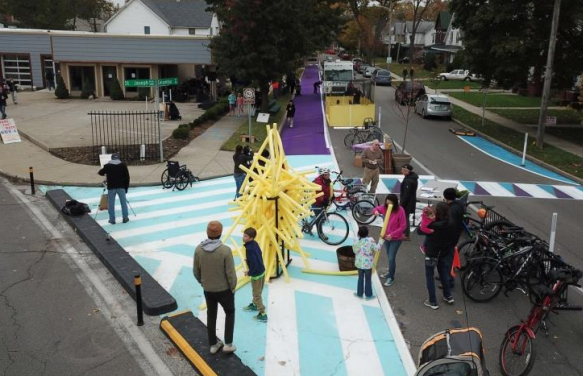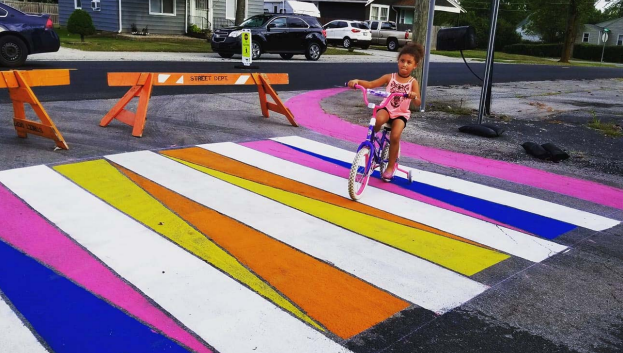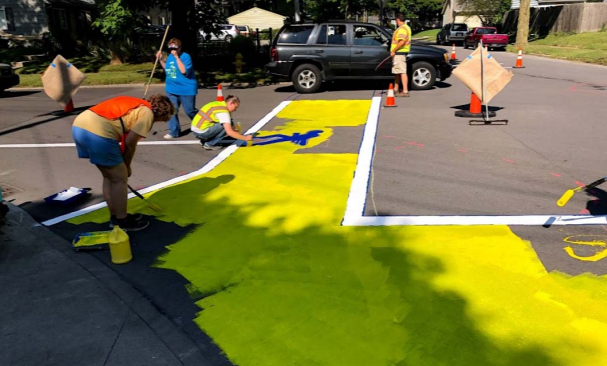
Neighborhood Traffic Calming
Traffic Calming is a program offered by the city to help residents work with the city on potentially making changes to residential streets to help improve traffic safety for street users, slow traffic and enhance the neighborhood. The goal of the program is to work with neighborhood associations on making positive changes in traffic after the neighborhood initiates the request. If a neighborhood request is valid, a review will be completed. Neighborhood traffic calming measures would then be installed if appropriate and supported by the neighborhood. This program is intended for roadways classified as residential streets with low traffic volumes, generally between 300 and 800 vehicles per day. Requests for 'collector' or 'arterial' streets will NOT be accepted.
The GOALS of Neighborhood Traffic Calming are:
- Reduce the speed of vehicles on residential streets, with demonstrated speeding problems, to levels consistent with the speeds of typical residential streets
- Increase safety by reducing demonstrated accident patterns on impacted residential streets to levels consistent with those of typical residential streets
- Develop and emphasize focused neighborhood educational programs to address traffic problems
- Discourage or eliminate non-local cut-through traffic
- Encourage neighborhood participation
- Minimize impacts to emergency vehicles
- Limit potential for shifting negative effects from one block to another block
For Neighborhood Traffic Calming to take place, the following PROCESS must be followed:
- Neighborhood Association Board must initiate a request to City Traffic Engineering Department
- The City will complete a site review
- The City will make site recommendations if there is no specific request
- The
 TRAFFIC CALMING PETITION FORM must be signed by 75% of the affected residents in favor of the change
TRAFFIC CALMING PETITION FORM must be signed by 75% of the affected residents in favor of the change - The implementation may occur (this may only be a trial period)
For additional information, please refer to the ![]() NEIGHBORHOOD STREET CALMING POLICY document.
NEIGHBORHOOD STREET CALMING POLICY document.
Community-Led Traffic Calming Demonstration Program
As Fort Wayne continues to grow, residents are looking for innovative ways to improve their neighborhoods. One area of interest to most residents is pedestrian and vehicular safety around and along roadways. The City is looking to give residents a way to explore the possibility of making temporary traffic-calming changes to their local streets. The process is citizen-driven, with the City of Fort Wayne Division of Public Works (DPW) and the Active Transportation Coalition of Allen County (ATC) assisting neighborhoods or other groups in developing safe and effective traffic calming plans. The Program helps citizens gain awareness of the requirements and work through the process of developing and possibly implementing traffic calming demonstration sites in their neighborhood. The program allows Fort Wayne citizens an opportunity to work with agencies to coordinate short-term experimental traffic calming techniques beyond speed reduction, standard pavement markings, and regulatory signs (i.e. stop signs). The program is intended to give citizens with a traffic calming idea a means to determine if the project is feasible and a process for implementing a demonstration project.
For additional information, please refer to the ![]() COMMUNITY-LED TRAFFIC CALMING DEMONSTRATION PROGRAM document.
COMMUNITY-LED TRAFFIC CALMING DEMONSTRATION PROGRAM document.

Painted Pavement Art Program
The purpose of the Painted Pavement Art Program is to support the Fort Wayne Public Art Master Plan by placing artistic designs on public streets in the City and supplementing the Community-Led Traffic Calming Demonstration Program. This program is intended to identify acceptable locations, enhance local artists and artwork and provide neighborhoods the ability to identify or brand their public spaces with beautification efforts. This program is also intended to help promote tourism in the neighborhood and establish a conversation with the community through public art.
For additional information, please refer to the ![]() PAINTED PAVEMENT ART PROGRAM document.
PAINTED PAVEMENT ART PROGRAM document.



